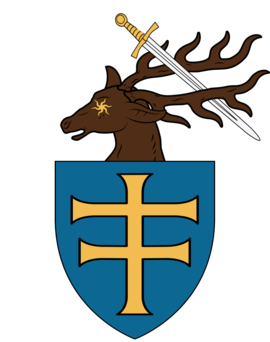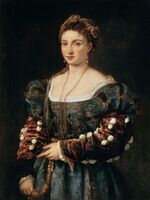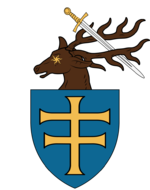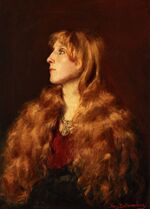House van Leuven
| |||||||||||||
The House van Leuven (Common: Leuven, New Marian: Leven, Waldenian: Löwen, Imperial: Leuven) is a Hanseti-Ruska household from the reign of King Karl III. Having been established as lesser nobility after parting from House Ashford de Falstaff to be allowed to assimilate into Hanseti culture without ties to the Savoyard family. As a result, the prideful house is known for its severe loyalty to the Hanseti-Ruska crown and its uncommon trend of matriarchy (as they’ve only had female leaders since its birth). They are known for their merging of Savoyard culture with that of Raevir.
Contents
History
With the problematic reign of King Frederick I of Oren, the nominated Lord Chancellor Conrad Ashford de Falstaff was noted to have often fallen into dispute with three of four daughters: Emelie Fransenca, Manon Yvaine, and Ophelie Eleanora. As a result in defiance of their ill-willed feelings and unsupportive claims of their father’s abusive nature, the three daughters turned to offered refuge in the Kingdom of Haense, all three taking wardship under Karl III and his wife Amadea of Susa. Meanwhile, in the warmer southern hemisphere Priscilla Amelia Ashford de Falstaff resided with her beloved sister Evanna Ashford de Falstaff, taking advantage of the latter’s close relation with Princess Stefaniya Joanna Ruthern, wife to Lucien I, Prince of Savoy. However, with the eventual downfall of the Principality of Savoy and rumored kin in Haense, Priscilla brought herself and tutelage to the winterland domain who housed her extended family, taking full claim as Matriarch of Ashford de Falstaff, and securing her position in the Kingdom. By growing closer with the three younger Falstaff ladies, notably Emelie widely, and dealing with the politics of her migration, Priscilla Amelia started to flesh out a plan to separate herself and Conrad’s kin from the familial namesake with a new identity purposefully for the nature of Haense. It is often cited that Priscilla held too much pride with her familial ties, knowing that the daughters were out of tune with their cultural history, and thus sought to break any connection and allow them to flourish under new recognition without the threat of assimilating House Ashford de Falstaff into the Haense culture and societal norms.
As the two different cousin branches merged into one with Priscilla Amelia assuming the role of guardian, she led the two active sisters Emelie Francesca and Manon Yvaine into cultivating a penned missive foretelling their recent modern familial histories, furthermore establishing their intent of separating from their birth namesakes and taking up the eponym House de Leuven. However, not the entirety of the three sisters nor Priscilla’s own children followed suit with the transition. Ophelia Eleanora previously in pursuit of joining her sisters opted out of adopting the newfound surname at the last moment, rumored for a variety of reasons, the most prominent one is that the birthname Ashford de Falstaff was more convenient in her apparent aspiration of marrying the Grand Prince of Kurosev Georg, prior to his ascension as King Georg I of Hanseti-Ruska. Additionally, Priscilla Amelia had a strained relationship with her own children, especially Ipera Antoinette and feared that they would tarnish the integrity of the foundation of House de Leuven.
As per agreement, Emelie Francesca assumed the appropriate standing as the first Matriarch of House de Leuven, holding a promising future with the household thanks to her education under Amadea of Susa. However, with her marriage to Aleksandro Ludovar the woman started to isolate herself from the royal courts of Haense, as well as the general populace. As a result she relocated herself and remaining family to the countryside with the hopes of securing a potential future for her Household through the less suffocating atmosphere of the setting. WIth time, the finances acquired from both her personal inheritance and remaining revenue of Priscilla’s mercantile company drained themselves without proper support of ongoing income. This dwindling state continued until the birth of her firstborn daughter Eugina, allowing her to quietly abdicate from any duties with growing illness up until her death.
Although not particularly well known, Eugina Marie stepped up to the plate to establish a better possibility for House de Leuven, acknowledging the fact that unlike other houses such a feat of being a notable Hanseti-Ruska household could not be done through one generation, but rather many overtime. Having grown to hate the countryside lifestyle due to its restraining nature, she fought to relocate back into the capital of Karosgrad nearer the later years of her life, having gained appropriate funding and stability to do so through her marriage to her beloved husband. Ritcher de Dyffryn provided funding as a banker and moneylender to lesser nobility and aristocracy in the Kingdom of House, specifically the outer duchies. As a result, Eugina Marie took advantage of this funding and moved to the city Karosgrad, living there until she was forced to depart from the realms of Arcas alongside other races of the four brothers, moving to the city of Valdev once settled in Aevos. There, she gave birth to two children: Adela Taronitissa and Nicholas Archibald.
Adela Taronitissa being the firstborn of Eugina Marie assumed the role of Matriarch, rumored by lesser historians to have had the potential of being one of the greater leaders of House de Leuven, if not for one complex issue. Her intense agoraphobia. Due to such fears of the outside world, speculated to be caused by the intense nature of the bustling Valdev city under Amaya of Venzia’s reign, Adela Taronitissa never having actually stepped foot out of her childhood home. Growing up in the household she made mostly lackluster acquaintances and correspondences through her penpalship. Some of the more notable ones being Queen Amaya of Venzia, Lady Anabel Elia Colborn, and the couple Baroness and Baron-Consort Irena Stefaniya and Gabriel Lukas Kortrevich. The hermit-historian met her husband Ratibor Reagan May through his father, who was her personal tutor growing up and one of the only people to ever see her in person. With the marriage to her childhood sweetheart. It is after this point Adela Taronitissa made one of the most formidable changes to the household, changing the formal namesake of the Household from Ashford de Leuven to van Leuven, recognizing a prosperous future for the household relied on being further embraced into the cultural normalities of Hanseti-Ruska.
Modern History
In recent years due to house fires both Adela Taronitissa and Ratibor Reagan passed away. As a result their firstborn daughter Adelina Claire van Leuven took over as heir at a young age. Thankfully, thanks to connection through joint brewery business, House Kortrevich under the reign of Baroness Irena Stefaniya who took in the group of siblings as wards. This allowed for the living children to take ahold of House van Leuven, pushing it further to greater heights under the direction of the eldest daughter aforementioned.
Traditions
Genology
Members of House van Leuven often share the common trait of pale flesh flushed with pink tints from the colder climate, their ancestors not akin to the weather often resulting in the appearance of cold-sensitive skin - although not physically true, as the later kin of the bloodline became akin to the climate. Their features are typically more stark and sharper unlike fellow human counterparts, resulting in shallow and sometimes gaunt angles to their complexions. Passed down the generations from the household von Rovin is thick and curly flaxen-colored locks, the most common hair for the household members. However, thanks to Rus-blooded wives from Ashford de Falstaff in the era of the War of the Two Emperors, thick and straight locks of deep brown colors are also ordinary. These two textures and colors can also interchange typically: curly and dark brown, straight and blonde, vice versa. Eye color is almost always the usual light blue tone, though can sometimes come in the form of a muddish olive green shade. Rarely, due to the de Dyffryn bloodline, hazel eyes nearer a light caramel coloring are possible. Finally, the height of van Leuven members can range anywhere from 5’9 to 6’4 for men and 5’6 to 6’ for women.
Naming
The most common names for members of House van Leuven are taken from Campagnois or Savoyardic origin. However, it is not unpopular for names to be taken from Raevir etymology and spelt out in the two previously mentioned languages. As such Aurora or Marina instead of Aurore or Marine might be used instead, allowing for the household to embrace Raevir naming tradition without entirely assimilating into the nature of Hasenti-Ruska. Some popular female names within the family include: Adela, Priscilla, Yvaine, Emelie, Amelia, Eugina, and Giovanna. Additionally some popular male names include: Conrad, Albert, Aleksander, Edourad, Paul, Anton, and August.
House Crest
After great debate and endless discussion among the trio: Priscilla Amelia, Emelie Francesca, and Manon Yvaine, the three managed to decide upon a household crest for their newfound household. Taking inspiration from both the insignia from House Ashford de Falstaff as well as Savoyardic symbols. The primary shield of the is a stark blue coloring with the lorraine cross from the Church of Canon, representative of unyielding devotion to said religion, meant to flamboyantly display the household’s zeal towards it. Above is the side view of a stag, used to show the more mystic nature of van Leuven’s and the greater knowledge and wisdom in the animal’s antlers shown with most depictions, reflective of the household’s ideals. As an ode to their Ashford bloodline a sun is planted in the creature’s eye as an icon for what the sun stands for in Savoyard culture. Finally as to portray the strength and loyalty to Hanseti-Ruska, a sword with golden hilt is woven in between the stag’s antlers in silent ode to both meanings equally balanced.
Heirlooms
Tiara of Leuven
Chaplet of Curonia
Halcourt Gemstones
Daniel’s Ring
Baiser de la Mort
Sisters of Leuven




